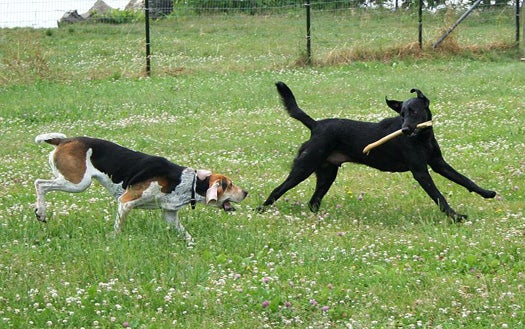The First Dogs May Have Been Domesticated In Central Asia
Scruffy's ancestors might come from Mongolia

The United States is home to an estimated 70 to 80 million pet dogs, making up 37 to 47 percent of all American households. We affectionately call them man’s best friend, and they are, in fact, humankind’s oldest “friend” in the animal kingdom. Canis familiaris, the domestic dog, was the first species to be domesticated by humans from Eurasian gray wolves at least 15,000 years ago. What is largely unknown, however, is where. A new genomic study, published today in the Proceedings of the National Academy of Sciences, offers up strong evidence that domesticated dogs originated in Central Asia, around modern day Nepal and Mongolia.
Previous genetic studies of dog lineages have concluded that domestication occurred in Southern China around 16,500 years ago, but the earliest archaeological evidence of domesticated canines is found in Europe and Siberia. All of this contrasting evidence has understandably created not a small amount of debate, but one thing that can be agreed upon is that all dogs came from Eurasian gray wolves at least 15,000 years ago. One key factor was largely neglected in previous studies, however.
Canis familiaris can be broken down into essentially two main groups: One of pure breeds and mixed breeds—about 400 types—that make up most American pets and another, much larger group of free-roaming and breeding populations known simply as “village dogs.” Despite the wide variation in outward physical appearance, pure breeds are not genetically very diverse, because they come from such small, controlled gene pools. (Remember, as crazy as it seems, a Chihuahua and a St. Bernard are still the same species.) Most modern breeds, in fact, are only about 200 years old (though artificial selection by humans on dogs has been occurring for thousands of years). The majority of dogs, along with their genetic diversity, fall in the group of “village dogs,” and have much older lineages than the pure breeds. It makes them particularly important when studying dog evolution. Adam Boyko, of Cornell University, and his colleagues factored this group of dogs heavily into their study.
Boyko’s team analyzed 185,800 genetic markers in 5,392 dogs, including 549 village dogs from 38 countries, making their study the largest ever of worldwide canine genetic diversity. They found that genetic diversity is highest in Central Asia, specifically Nepal and Mongolia. Genetic diversity then fans out like ripples in a pool, with areas like Afghanistan, Egypt, India, and Vietnam—all ringing around the possible center of origin in Central Asia—having the next highest levels and so on. “It mirrors what we see in humans and how they spread out of East Africa,” says Boyko.
Dogs studied in geographic regions farther away, like the South Pacific and Americas were almost exclusively of European origin. This complicates things a bit, but the reason for that is likely the spread of modern Western culture and the appeal of pure breeds. “Everybody wants a golden retriever,” says Boyko. Perhaps one of the reasons village dogs with more indigenous traits have not been overcome by foreign gene flow in Central Asia is because they originated there and have large populations. They also might be better adapted to that environment, notes Boyko.
“At Bichon Frise running wild in Mongolia is not going to do very well,” he says, “But if Ulaanbaatar (the capital) became the next biggest city in Asia, then perhaps some Bichons would do alright there,” and mix with the indigenous village dogs.

Canis lupus , Eurasian Gray Wolf
No one knows what the domestication of wolves looked like or how it happened, but scientists and historians have thrown out some loose guesses.
In the study, Boyko and his colleagues note that human hunter-gatherers and gray wolves were both present in the Central Asian steppe 15,000 years ago hunting on the huge grazing mammals that roamed around there. They posit that perhaps advanced blade hunting techniques by humans, or climate change, decreased available prey for the wolves, who then turned to scavenging scraps from bands of humans. Perhaps these wolf scavengers started to evolve scavenging traits to the point where they became completely reliant on scraps from humans for sustenance. No one can really be certain, but it’s hard not to let the imagination go wild when trying to picture what these early human-wolf encounters looked like. You can almost see a hungry wolf slowly coming up to the campfire, nervous, curious, and submissive, to take the scrap from a human hand.
That’s certainly a simplified, even romanticized version of these first encounters, but who can say with 100 percent certainty how these situations unfolded? What Boyko’s study does show is the first strong evidence of where the cradle of dog civilization might lie, which could in turn help in figuring out how they came to be. These populations of indigenous dogs, however, are quickly succumbing to gene flow from foreign dogs, so further studies are vital for understanding the relationship with our oldest animal companions.